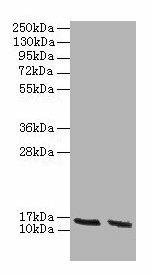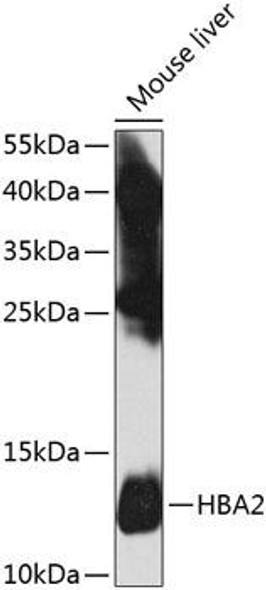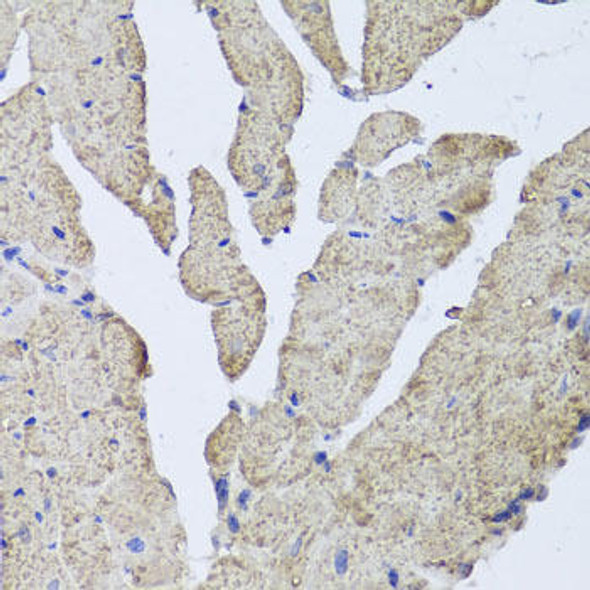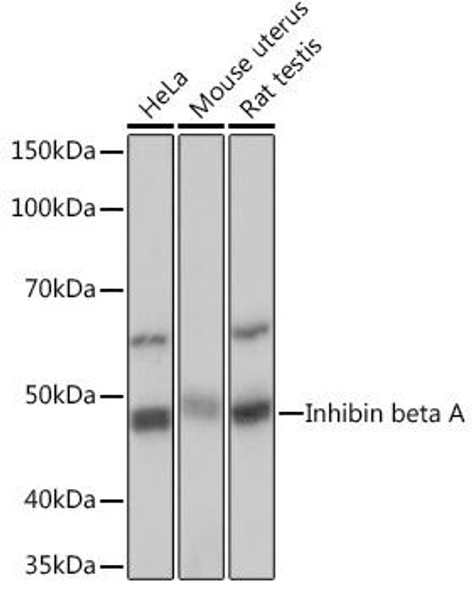Hba Antibody (PACO27313)
- SKU:
- PACO27313
- Product Type:
- Antibody
- Reactivity:
- Mouse
- Human
- Host Species:
- Rabbit
- Isotype:
- IgG
- Applications:
- ELISA
- WB
- Antibody Type:
- Polyclonal Antibody
- Conjugation:
- Unconjugated
Description
Hba Antibody (PACO27313)
The HBA Antibody (PAC027313) is a polyclonal antibody specifically designed for research involving the HBA protein. HBA is a crucial component of hemoglobin, the protein responsible for transporting oxygen in the blood. This antibody, raised in rabbits, exhibits high reactivity with human samples and is validated for use in various applications, including Western blotting. By binding to the HBA protein, this antibody allows for the detection and analysis of HBA in different cell types, making it an ideal tool for studies in hematology and related fields.HBA plays a vital role in oxygen transport and delivery throughout the body, making it essential for understanding conditions related to oxygen deficiency or blood disorders.
Research on HBA can provide insights into diseases such as anemia, sickle cell disease, and hemoglobinopathies. By studying the functions and interactions of HBA, researchers can potentially develop new diagnostic tools and therapeutic interventions for these conditions.Overall, the HBA Antibody (PAC027313) is a valuable tool for researchers seeking to investigate the role of HBA in health and disease. Its specificity and reliability make it a trusted resource for studies aiming to unravel the complexities of hemoglobin and its implications for human physiology and pathology.
| Antibody Name: | Hba Antibody (PACO27313) |
| Antibody SKU: | PACO27313 |
| Size: | 50ug |
| Host Species: | Rabbit |
| Tested Applications: | ELISA, WB |
| Recommended Dilutions: | ELISA:1:2000-1:10000, WB:1:1000-1:5000 |
| Species Reactivity: | Mouse, Human |
| Immunogen: | Recombinant Mouse Hemoglobin subunit α protein (2-142AA) |
| Form: | Liquid |
| Storage Buffer: | Preservative: 0.03% Proclin 300 Constituents: 50% Glycerol, 0.01M PBS, PH 7.4 |
| Purification Method: | >95%, Protein G purified |
| Clonality: | Polyclonal |
| Isotype: | IgG |
| Conjugate: | Non-conjugated |
 | Western blot All lanes: Hba antibody at 2µg/ml Lane 1: HepG2 whole cell lysate Lane 2: Hela whole cell lysate Secondary Goat polyclonal to rabbit IgG at 1/10000 dilution Predicted band size: 16 kDa Observed band size: 16 kDa . |
| Synonyms: | Hemoglobin subunit α (Alpha-globin) (Hemoglobin α chain), Hba, Hba-a1 |
| UniProt Protein Function: | HBA1: Involved in oxygen transport from the lung to the various peripheral tissues. Defects in HBA1 may be a cause of Heinz body anemias (HEIBAN). This is a form of non-spherocytic hemolytic anemia of Dacie type 1. After splenectomy, which has little benefit, basophilic inclusions called Heinz bodies are demonstrable in the erythrocytes. Before splenectomy, diffuse or punctate basophilia may be evident. Most of these cases are probably instances of hemoglobinopathy. The hemoglobin demonstrates heat lability. Heinz bodies are observed also with the Ivemark syndrome (asplenia with cardiovascular anomalies) and with glutathione peroxidase deficiency. Defects in HBA1 are the cause of alpha-thalassemia (A- THAL). The thalassemias are the most common monogenic diseases and occur mostly in Mediterranean and Southeast Asian populations. The hallmark of alpha-thalassemia is an imbalance in globin-chain production in the adult HbA molecule. The level of alpha chain production can range from none to very nearly normal levels. Deletion of both copies of each of the two alpha-globin genes causes alpha(0)-thalassemia, also known as homozygous alpha thalassemia. Due to the complete absence of alpha chains, the predominant fetal hemoglobin is a tetramer of gamma-chains (Bart hemoglobin) that has essentially no oxygen carrying capacity. This causes oxygen starvation in the fetal tissues leading to prenatal lethality or early neonatal death. The loss of three alpha genes results in high levels of a tetramer of four beta chains (hemoglobin H), causing a severe and life-threatening anemia known as hemoglobin H disease. Untreated, most patients die in childhood or early adolescence. The loss of two alpha genes results in mild alpha-thalassemia, also known as heterozygous alpha-thalassemia. Affected individuals have small red cells and a mild anemia (microcytosis). If three of the four alpha-globin genes are functional, individuals are completely asymptomatic. Some rare forms of alpha-thalassemia are due to point mutations (non- deletional alpha-thalassemia). The thalassemic phenotype is due to unstable globin alpha chains that are rapidly catabolized prior to formation of the alpha-beta heterotetramers. Alpha(0)-thalassemia is associated with non-immune hydrops fetalis, a generalized edema of the fetus with fluid accumulation in the body cavities due to non-immune causes. Non- immune hydrops fetalis is not a diagnosis in itself but a symptom, a feature of many genetic disorders, and the end-stage of a wide variety of disorders. Defects in HBA1 are the cause of hemoglobin H disease (HBH). HBH is a form of alpha-thalassemia due to the loss of three alpha genes. This results in high levels of a tetramer of four beta chains (hemoglobin H), causing a severe and life-threatening anemia. Untreated, most patients die in childhood or early adolescence. Belongs to the globin family.Protein type: CarrierCellular Component: hemoglobin complex; membraneMolecular Function: haptoglobin binding; heme binding; organic acid binding; oxygen binding; peroxidase activityBiological Process: erythrocyte development; in utero embryonic development |
| UniProt Protein Details: | |
| NCBI Summary: | |
| UniProt Code: | P01942 |
| NCBI GenInfo Identifier: | 122441 |
| NCBI Gene ID: | 15122 |
| NCBI Accession: | P01942.2 |
| UniProt Secondary Accession: | P01942 |
| UniProt Related Accession: | P01942 |
| Molecular Weight: | 17 kDa |
| NCBI Full Name: | Hemoglobin subunit alpha |
| NCBI Synonym Full Names: | hemoglobin alpha, adult chain 1 |
| NCBI Official Symbol: | Hba-a1 |
| NCBI Official Synonym Symbols: | Hba; Hba1; Hbat1 |
| NCBI Protein Information: | hemoglobin subunit alpha |
| UniProt Protein Name: | Hemoglobin subunit alpha |
| UniProt Synonym Protein Names: | Alpha-globin; Hemoglobin alpha chain |
| Protein Family: | Hemoglobin |
| UniProt Gene Name: | Hba |
| UniProt Entry Name: | HBA_MOUSE |











